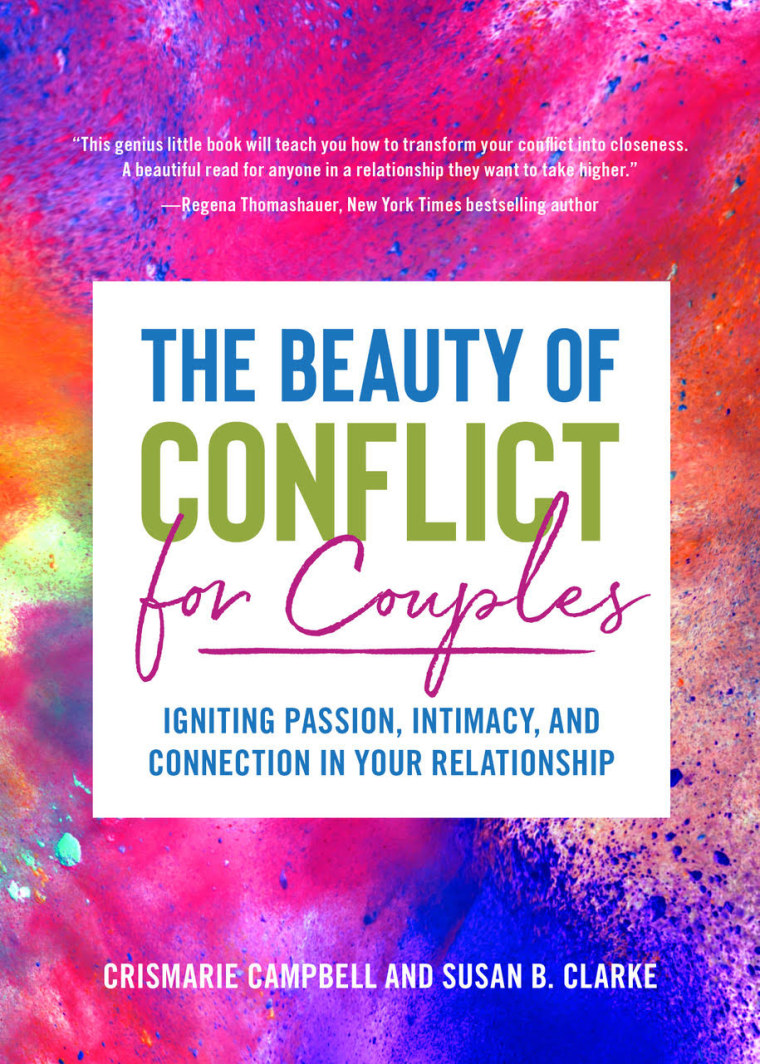Susan Clarke is a long-time cancer survivor who forged a path in business consulting. CrisMarie Campbell is a former Olympic rower and aerospace engineer. The married couple have their differences, but conflict keeps them united.
In their new book “The Beauty of Conflict for Couples,” Clarke and Campbell argue that conflict is an overlooked solution to problems around intimacy and fulfillment in relationships.
When two people are in love, conflict can feel threatening, but when they harness conflict the right way, they can make the bond stronger, according to the authors.
Here’s how Campbell and Clarke, co-founders of Thrive!, an organization that specializes in resolving relationship and workplace conflict, use disagreement to strengthen their own bond, and how they say other couples can do the same.
They use the “5-5-5” method to work through problems
The 5-5-5 method is simple, according to Clarke. When a disagreement comes up, each partner will take 5 minutes to speak while the other simply listens, and then they use the final five minutes to talk it through.
“My job is to just listen, and then she’ll listen and I’ll talk for 5 minutes, and then we dialogue about it for the last five minutes,” Clarke says. “And it’s important to keep it a 5-5-5, not a 5-5-45.”
The couple, who have been married since 2006, recalls using the method to work through a conflict they experienced while on vacation in Mexico. Campbell told Clarke she felt unhappy in the relationship.
Every day they were on vacation, they used the method to talk through their problems. By the end, Campbell realized she had been unfairly blaming Clarke for her unhappiness.
“I wasn’t doing the work that I wanted, I wasn’t doing anything fun,” says Campbell. “And so I got clear that I wanted to do more dance, and acting, and painting. It really, through the process, helped me digest internally what was going on for me.”

Campbell says the beauty of 5-5-5 is that it only takes 15 minutes, and gives each partner the opportunity to say how they feel, and then discuss it without the conflict spiraling out of control.
“You’ll be solving a whole different problem,” she says, “because you’re solving more around the core values or what’s out of alignment versus ‘you’re just not the person for me.’”
Couples who are not used to talking through conflict this way may have a rough time getting started. To make it easier in the beginning, Clarke and Campbell recommend beginning with only three minutes each (3-3-3), and then building the discussion to 5-5-5 as you get more comfortable.
“No boundaries, no conflict”
Conflict is a healthy part of a relationship, but many people feel that conflict means their relationship isn’t working. Not true, says Clarke. Conflict actually means there is still passion in the relationship, she says. In fact, if you aren’t having any conflict, she says, it can be an indication that you’ve become indifferent, or that one partner has completely given in to the other.
“Usually, when a couple doesn’t have any tension, or doesn’t have any fighting, they’re probably not showing up, and at some point that’s going to be difficult,” Clarke says.
Adds Campbell: “That really means they’ve stopped showing up, risking saying something that might upset their partner.”
Campbell has a phrase for tension-free relationships: “No boundaries, no conflict.”
“If you’re not saying ‘Hey, this is what I want, this is what I don’t want,’” she explains, “that’s a boundary statement. If I don’t do that, then sure, we’re going to get along just fine because I’m going to go along with you. I’m giving up myself in that relationship.”
Be a full ‘me’ in the face of a ‘we’
Regular conflict is a good sign that you and your partner are each maintaining a healthy sense of self, according to the relationship experts.
Where couples often go wrong, they explain, is when they disrespect each other’s boundaries.
For example, one partner may blame the other as being the problem, they say, failing to recognize their own role in the conflict.
During your 5-5-5, Clarke and Campell advise keeping focused on your own feelings instead of framing your partner as the problem. Avoid using “you” and “we” statements, they say. Instead, focus on using “me” and “I.”
“It’s not like I can’t talk about the other person, but I’m talking about it from owning my interpretation versus an absolute truth,” says Campbell.
It’s also common for couples to assume they are absolutely right and their partner is absolutely wrong, say the authors. Instead of assuming your better half is wrong, be curious about their perspective, and encourage them to explain how they got to it. Campbell says this will help you better understand them.
Be quiet and listen
During your 5-5-5, do not interrupt your partner. Often, when we interrupt, it’s because our partner is saying something that makes us uncomfortable. In these situations, the interrupting partner will usually interject with apologies or solutions, but they are really trying to “manage the tension instead of just listening,” says Clarke. She says you need to fight through your own discomfort and allow your partner to say what they need to say.
Recognize your emotions as they become physical reactions
Everyone reacts differently in conflict situations, says Campbell. For example, one partner may clam up, the other may yell. While arguing, Campbell says it’s important to be aware of your physical state. She says some couples may need to take a time out before talking.
Go into another room or for a walk until the tension eases, she says. If your partner is the one who is upset, allow them to have space from you until they are calmer. When you’re in a better physical and mental state, you will be in a better position to communicate effectively.
See a couples therapist
If you’ve tried everything and the conflict still seems unresolvable, it may be best to separate. But you should see a couples therapist before making that final decision, says Clarke. The situation may still be repairable even if it doesn’t feel like it.
How the 5-5-5 method makes their relationship complete
Campbell and Clarke say learning to manage conflict and maintain healthy boundaries has made their relationship whole.
“It’s really important for me to continue to come forward and be all of me,” says Clarke.
“I continually am invited to come to the edge of what is comfortable for me,” says Clarke. “So I get to keep exploring how to know more about myself, how to be more consciously engaged with other people.”
MORE RELATIONSHIP ADVICE
- How to improve your sex life: 4 tips for couples
- How one couple saved their marriage by asking this simple question
- How thoughtful communication can improve your marriage, according to a divorce attorney
- How to use these common relationship conflicts to strengthen your bond
Want more tips like these? NBC News BETTER is obsessed with finding easier, healthier and smarter ways to live. Sign up for our newsletter and follow us on Facebook, Twitter and Instagram.



